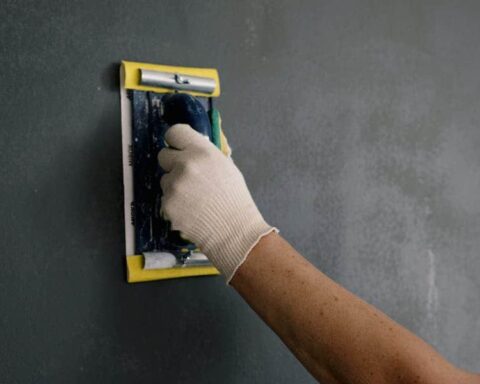Spray paint has become a favorite medium for graffiti artists and hand-painting enthusiasts. It’s affordable, accessible, and produces extremely vibrant results. While spray paint may seem like a permanent medium, it is actually quite easy to remove from most surfaces once you know how to do it properly. If you don’t take precautions, you will have yellow hands for days after removing the paint from your surface of choice. Follow these simple steps to learn how to get spray paint off your hands.
How Do You Get Spray Paint Off Your Hands?
1. Try baby oil
First, don’t panic, the situation isn’t as bad as you think. If you’re in a pinch, get your hands on some baby oil as quickly as possible because it works wonders. Just apply it generously to your hands after you finish and you should start to see the paint start to come off. Baby oil is great for preventing and removing paint from your hands because it’s so light and gentle. You can also use other oils like mineral oil or corn oil since they’re very similar. You can also try coconut oil as an alternative, though it might take a bit longer to work.
2. Use a dryer sheet
Dryer sheets are incredibly useful and versatile, so it’s no surprise they also work well on paint. Just rub the fabric of the dryer sheet against the paint on your hands and it should come right off. Dryer sheets are made with a variety of ingredients, but most contain a lot of fabric softeners. These chemicals, while harmless to most people, are very effective at removing paint. You don’t want to use the sheet itself, though, as the thick fabric will be too abrasive for your hands. Just rub the thin fabric against your hands as if you were wiping it off.
3. Go with solvent-based paint thinner
If you have a solvent-based paint thinner like turpentine or mineral spirits, then you’re in luck. You can use these products to strip your hands of almost all of the paint, though be warned that they’re very potent and can irritate your skin. If you’re not careful, you might even cause chemical burns. If you use paint thinner on your hands, make sure you wash them thoroughly with soap and water as soon as possible. You can use a hand sanitizer to get your hands clean and kill any germs that might have been transferred.
4. Try hand sanitizer
Hand sanitizer can be an excellent tool to remove paint from your hands, but make sure it’s alcohol-free. You’re not looking to disinfect your hands; you just want the paint to come off. Just apply a good amount of sanitizer and rub it into your hands. The paint will start to disintegrate and fall off. Hand sanitizer is much stronger than you may realize, so be careful not to get it on your skin or anywhere else.
5. Try baking soda
Baking soda is a very mild abrasive that is gentle enough to be used on your skin. While it’s not something you would normally be recommended to use on your hands, it can be extremely effective for removing paint. Just sprinkle some baking soda onto your hands and scrub the paint away. Since baking soda is so fine, it will easily break apart the paint and leave your hands looking clean and fresh. Just be sure to scrub gently so you don’t irritate your skin.
What You’ll Need
- Rubbing Alcohol – This will help break down the chemical bonds between the paint and your skin.
- Paper Towels – These will allow you to wipe away excess paint and clean the sprayed area.
- Coarse Salt – This will help break down the paint and allow it to be wiped away easily.
- Mineral Spirits – Mineral spirits are a solvent that will help break down the chemical bonds between the paint and your skin.
- Eye Protection – Put on safety goggles to protect your eyes from any flying paint particles.
- Gloves – Avoid leaving paint on your hands by wearing gloves while you clean it up.
Why You Get Spray Paint Off Your Hands
The Dark Side of Spray Paint
Spray paint is, by nature, a dark substance. This means that it does not produce a clean, light-colored mark as a marker would. Instead, the marks it leaves are darker and tend to be more difficult to remove. This is especially true if you don’t clean your spray paint off your hands before it dries. Spray paint also contains various elements that can make it stick to your hands. So, even if you clean it off as soon as you’re done with it, there’s a chance that it will get stuck to your skin before you know it. The darker the paint, the harder it is to remove.
Your Hands are Dirty
Spray paint loves to get stuck to messy, dirty hands. This is because the dirt and oils on your hands help the paint stick to them. If you want to make sure that the paint doesn’t stick to your hands, you’ll need to make sure you clean them well. You should wash your hands with soap at least once every couple of hours. If you do graffiti for a living, you should also keep a small bottle of hand sanitizer with you along with a clean handkerchief or towel to wipe your hands dry when you’re done. If you don’t wash your hands regularly, the paint is going to stick to them regardless of any other precautions you take. If you have particularly dirty hands, you may need to scrub them with a cleaning agent first before washing them with soap. This will help you prevent the paint from getting stuck to your hands.
You Hold Your Can Wrong
There’s a right way to hold a can of spray paint, and you need to make sure that you hold it correctly. If you hold the can incorrectly, you’ll end up covering your hands, as well as your clothing, in paint. This is especially true if you’re spraying upwards. Make sure that you’re holding the can at a 45-degree angle when you spray and that you’re holding the can about 2 feet away from what you’re spraying. If you hold the can too close, it won’t be able to spray correctly. If you’re holding the can correctly, the paint should spray upwards and then fall back down before it reaches you. This means that you should be able to avoid getting paint on your hands. However, you should still take precautions to make sure that it doesn’t happen. Make sure to always wear gloves when you’re spraying. This will help protect your hands if some paint does manage to land on them.
Spray Paint Off Hands Method
- The first step to removing spray paint from your hands is to fully cover the painted areas.
- Once they are covered, you can wipe them clean with a paper towel saturated in rubbing alcohol.
- Be careful not to scrub the area too vigorously; you don’t want to damage your skin.
- After cleaning the painted areas, you can rinse them off with water to remove any leftover paint particles.
Coarse Salt Spray Paint Removal Technique
- Spray paint will often dry on a surface in layers.
- If a surface has multiple layers of paint, you may need to remove the top layer before removing the bottom layer.
- To do this, sprinkle coarse salt over the painted area, and let it sit for a few minutes.
- Next, use a scrub brush to scrape away the top layer of paint.
- Once the top layer is removed, apply mineral spirits to clean off the rest of the paint.
Mineral Spirits Spray Paint Removal Technique
- Spray paint is often made from a mixture of solvents, resins, and pigments.
- Mineral spirits are a solvent that breaks down these chemical bonds and helps remove the paint.
- To clean a surface with mineral spirits, hold a clean rag in the solvent and gently wipe away the paint. Wipe the area until it is clean.
- Make certain to dispose of the rag after cleaning the surface to avoid leaving mineral spirits on other areas.
Dry Wallpaper Adhesive Spray Paint Removal Technique
- Spray paint is sticky and often leaves a residue behind when it dries.
- This is especially common when it is applied to porous surfaces, such as wood.
- If you are working with a surface that has been covered in wallpaper, you can use wallpaper adhesive to clean it.
- This will help break down the chemical bonds between the paint and the surface.
- It is important to note that wallpaper adhesive is extremely messy and will likely leave a trail of residue behind once it is removed.
- You may want to consider hiring a professional to remove the paint from your surface.
Conclusion
Spray paint is a versatile and inexpensive medium. While it is easy to work with and produces vibrant results, it is also easy to clean up after if you know what you’re doing. Before using spray paint, make certain to cover all nearby surfaces to protect them from getting paint on them. Once you’re done working with the paint, follow these directions to clean up. You’ll be left with clean hands and an exquisite piece of art.










